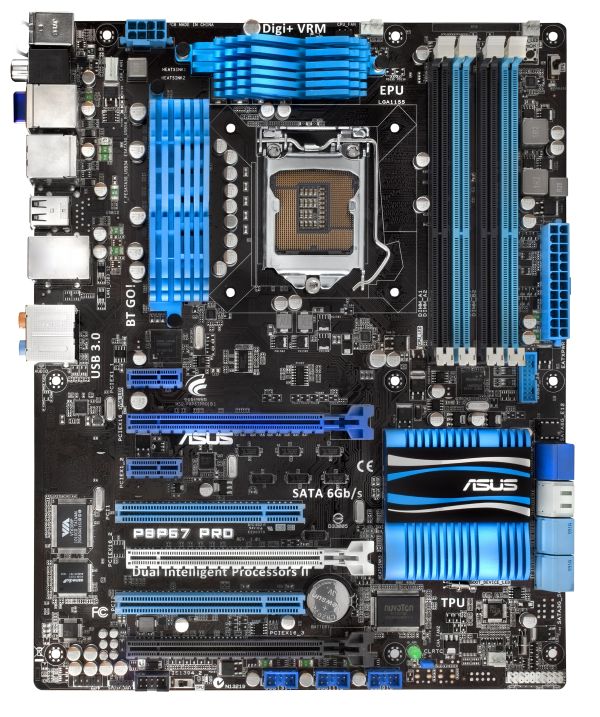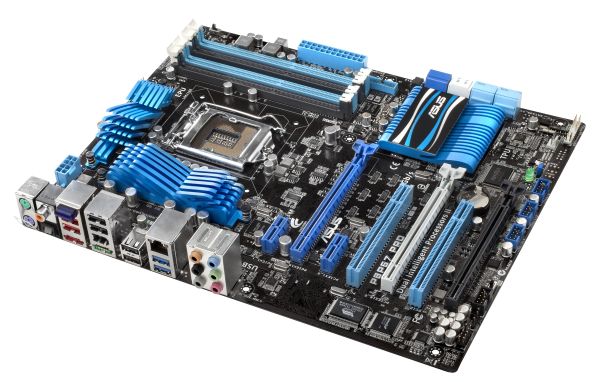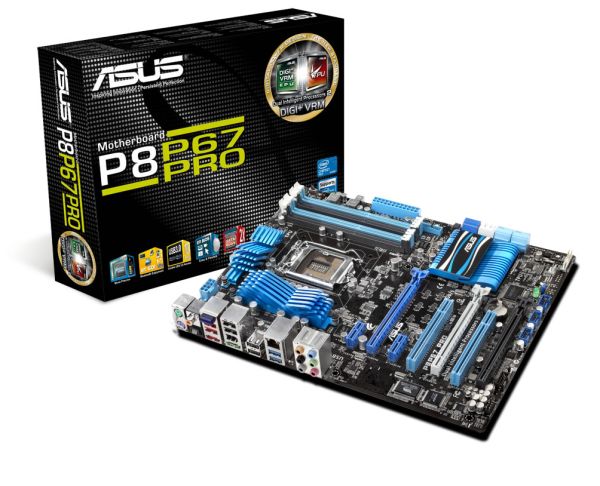The Battle of the P67 Boards - ASUS vs. Gigabyte at $190
by Ian Cutress on January 20, 2011 4:15 PM EST- Posted in
- Motherboards
- Gigabyte
- Asus
- P67
The ASUS P8P67 Pro fits near the beginning of the line-up in the ASUS launch, which in terms of ATX sized boards include the P8P67, the P8P67 Pro, the P8P67 Evo, the P8P67 Deluxe, the Sabertooth P67, the P8P67 WS SuperComputer and the top end Maximus IV Extreme. Therefore, with that in mind, we would expect to be looking at something above the base – slightly more (or better) features than the cheap boards available, enough to warrant the price difference. An overview of the P8P67 series is below:
| P8P67 Series | ||||||
| P8P67 LE | P8P67 | P8P67 PRO | P8P67 EVO | P8P67 Deluxe | ||
| Price | $140 | $160 | $190 | $210 | $235 | |
|
SATA 6 Gb/s SATA 3 Gb/s eSATA |
3 4 1 |
4 4 1 (bracket) |
4 4 2 |
4 4 2 |
4 4 2 |
|
|
CrossFireX SLI |
Yes No |
Yes No |
Yes Yes |
Yes Yes |
Yes Yes |
|
|
USB 3.0 USB 2.0 |
2 14 |
4 (2 via header) 12 |
||||
| LAN | 1 | 1 | 1 | 2 | 2 | |
| Bluetooth | No | Yes | Yes | Yes | Yes | |
Visual Inspection
ASUS have gone with the blue/white/black livery for the Pro board, with a 12+2 digital VRM design covered by slanted blue heat sinks. The socket itself is relatively clear, easily allowing large 1155/1156 CPU coolers to be fitted (remember, 1155 mounting holes are the same as 1156). The CPU fan header is located at roughly one o’clock from the socket itself, with a chassis header to the right of the DIMM slots, presumably for HDD bay type fans.
Next to this header are the EPU switch and the MemOK buttons. The EPU switch enables Energy Processing Unit, which is geared towards saving energy – this encompasses power gating certain features that are never used/used rarely, and declocking when less compute is required. The MemOK button is a physical override for overclocked memory – by holding it down until the red light comes on, at next boot, the UEFI will override the memory settings to something more suitable.
The SATA connectors come in blue (SATA 3 Gb/s), white/grey (SATA 6 Gb/s provided by the chipset) and navy blue (SATA 6 Gb/s provided by a Marvell controller). There is a USB 3.0 header also here, near the DIMM slots. These are all next to the ASUS logo and chipset cooler, which underneath have another chassis header and a green power light. This board is lacking both a debug LED and power/reset buttons on the main board, much to our disappointment.
The PCI slots are well laid out, with a PCIe 1x at the top and enough space between the first two PCIe x16 for a PCI card, meaning that at least one is available if all three PCIe x16 are occupied with dual slot cards. The black PCIe x16 slot is wired up as an x4 slot (as it shares bandwidth with the x1 slots, two USB 3.0 ports and the eSATA ports), and with a dual slot card in there, will cover most of the board USB headers.
The TPU switch is underneath the PCI slots, and performs the same function as the TurboV EVO software in the OS to optimise the system for a decent and stable overclock.
The back panel is standard, with dual PS/2 connectors, SPDIF outputs, USB 2.0 slots, USB 3.0 slots, Firewire, eSATA, audio and Ethernet. The blue module three from the left is the ASUS Bluetooth module, designed to communicate with Bluetooth devices to enhance overclocking or utilise music management. The gigabit Ethernet is handily powered by an Intel chip.














137 Comments
View All Comments
Hogan773 - Friday, January 21, 2011 - link
No - its 42 dollars more for the Extreme 6 vs Extreme 4.If it were 10 bucks like you said, I'd get the 6. But not for 40 bucks.
cjs150 - Friday, January 21, 2011 - link
to full fat ATX boards anymore?With all the features being crammed in surely 99% of all users were find their needs met with a decent micro-atx board - heck probably 60%+ would be fine with a mini-ITX board.
Seriously do we really need 3 graphics card slots, 2 way SLI/Crossfire is overkill for the vast majority of people.
As on board sound gets better and better most people have given up on a sound card.
The most slots I have populated over the last 5 years is 5 (2 graphics cards, sound card, TV tuner and RAID card) and that was truly the exception. These days all I need is 3 cards for 2 way SLI and a TV tuner
strikeback03 - Friday, January 21, 2011 - link
Would also help if PCI disappeared so there was no question over what slots were included/available with certain cards. For example, the uATX board in my HTPC has 1 PCIe X1, 1 PCIe X16, and 2 PCI, which meant I had to get a PCI wireless card and if I wanted to add any additional tuners would have to get PCI for that as well, would have preferred more/all PCIe.Also, the spot in my desk for a tower isn't getting any smaller, no reason to not use a full-size ATX board with that much space.
7Enigma - Tuesday, January 25, 2011 - link
Yup. I have the space for a mid/full tower below my desk. It does no good for me to have a m-atx (actually it'd make it worse since it would be lower for the optical drive!). I also hate playing the cram game when trying to build and work on systems that are in such tight confines.Sure for people with very limited space or HT setups it's nice to have a smaller form factor, but a LOT (the majority?) of desktop users have a similar setup where space is rarely a real issue and the extra real-estate for cable management, component selection/replacement, and airflow/noise is a much greater factor.
seamusmc - Friday, January 21, 2011 - link
Gigabyte's and ASUS' offerings at the $150 price point. The main difference between ASUS' Pro and Non-Pro are SLI support and the Intel Nic.Personally I'd love to see a review of cheaper boards. Would it significantly reduce price if they didn't include on-board audio?
The main reason I'm considering the Pro is the Intel Nic, though I'm not sure if its really a big deal.
Another reason I am considering ASUS is that Gary Key and his staff are on the Xtreme and HardOCP forums addressing issues folks are encountering, providing OC guides and updated BIOS not available from the official site.
Not saying that there are no issues with the ASUS line, there are, but it seems many problems with the ASUS line are corrected by a) Using 1.5v memory; b) Fresh install of Win7; c) Over-clocking correctly, some folks are trying things that don't apply to SandyBridge.
Arbie - Friday, January 21, 2011 - link
We are six pages into the discussion with no signs of an idiotic flame war! This must be a recent record for Anandtech. Whatever the reason, it's certainly refreshing.7Enigma - Tuesday, January 25, 2011 - link
Trolls are still sleeping. And since it's not the normal FW companies (Intel vs. AMD, Nvidia vs. ATI).jfelano - Friday, January 21, 2011 - link
I don't understand the point of testing just TWO boards at a $190 price point. Makes no sense.DanNeely - Friday, January 21, 2011 - link
Maybe only Asus and Gigabyte gave $190 boards to review...LoneWolf15 - Friday, January 21, 2011 - link
While this may not be worth it to many, note that the ASUS board has an Intel gig NIC, and the Asrock has a Realtek.This also means (for what it's worth) that the ASUS board supports Intel VPro, while the Asrock does not. For many people, that isn't a factor --but it is worth knowing.
Just looked at that Asrock board --I think it's the first I've seen by them that I found really impressive on paper. I might have to read some reviews on it.